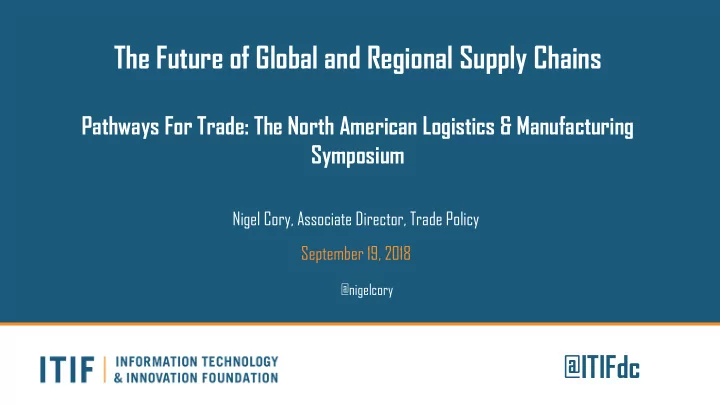

The Future of Global and Regional Supply Chains Pathways For Trade: The North American Logistics & Manufacturing Symposium Nigel Cory, Associate Director, Trade Policy September 19, 2018 @nigelcory @ITIFdc
About ITIF The world’s leading science and technology policy think tank. Supports policies driving global, innovation-based economic growth. Focuses on a host of issues at the intersection of technology innovation and public policy across several sectors: – Innovation and competitiveness – IT and data – Telecommunications – Trade and globalization – Life sciences, agricultural biotech, and energy 2
ITIF Global Engagement 3
Contents Global Value Chains 1 GVCs and U.S.-Mexico Trade 2 GVCs and Regional and Multilateral Trade Policy 3 4
Global Value Chains (GVCs) Traditional Trade: Simple, final products traded between a closely connected producer and seller. Modern Trade: System of specialization where different stages of production are located across firms in different countries. Emergence of GVCs driven by: – Decreasing transportation costs and increasing adoption of ICTs. – Rising productivity and incomes around the world driving increased demand for an ever-growing variety of goods and services. 5
U.S. and Mexico - GVC Participation 6
The Growth of Trade in Intermediate Goods/Services “Value - added” in modern trade lies in intermediate goods/services coming together in a final product. – From 2004 to 2014: Trade in intermediate goods increased from one-quarter to two-fifths of global trade. Difficult to measure and analyze: Dearth of data on GVCs. 7
Upcoming ITIF Trade Linkages Report Report looks into the changing nature of value-added trade between the United States and Mexico. – Focuses on key tech sectors: ICT manufacturing and automobiles. – Covers: The United States, Mexico, Taiwan, and South Korea. Goal: Provide an updated assessment of bilateral trade linkages and competitive positions of the two economies. 8
U.S.-Mexico Trade: Rising Together 9
U.S. Trade Balances in Value-Added Terms 10
U.S. Trade Adjusted by Value-Added 2002/2014 (Millions) Inter-Industry (Gross) Inter-Industry (VA-adjusted) Intra-Industry (VA) Country Year Exports Imports Balance Exports Imports Balance Exports Imports Balance Taiwan 2014 $24,088 $40,584 -$16,496 $16,415 $34,050 -$17,635 $5,304 $4,951 $352 Mexico 2014 $193,345 $293,916 -$100,571 $178,587 $267,366 -$88,778 $42,200 $29,078 $13,123 Korea 2014 $42,138 $68,679 -$26,541 $43,887 $78,341 -$34,454 $7,867 $9,300 -$1,434 Taiwan 2002 $16,774 $32,002 -$14,481 $13,331 $28,601 -$15,270 $4,885 $3,440 $1,445 Mexico 2002 $86,015 $133,969 -$67,283 $88,999 $132,158 -$43,158 $23,113 $12,926 $10,186 Korea 2002 $21,131 $35,276 -$17,048 $22,922 $37,098 -$14,176 $5,802 $3,456 $2,346 11
U.S. Trade in Intermediate Products World South Korea Mexico Taiwan 2002 2017 2002 2017 2002 2017 2002 2017 Exports Capital Goods 26% 21% 32% 28% 15% 14% 33% 28% Intermediate Goods 65% 68% 63% 66% 76% 81% 63% 67% Consumption Goods 9% 11% 5% 6% 9% 5% 4% 5% Imports Capital Goods 21% 26% 28% 28% 28% 39% 39% 29% Intermediate Goods 55% 50% 48% 62% 57% 49% 41% 55% Consumption Goods 24% 24% 24% 10% 15% 12% 20% 16% 12
U.S. Trade with Mexico, Adjusted by Value Added, 2014 Mexico (2014) Inter-Industry (Gross) Inter-Industry (VA) Intra-Industry (VA) Industry Exports Imports Balance Exports Imports Balance Exports Imports Balance $293,916 -$100,571 -$88,778 $42,200 $29,078 $13,123 $193,34 $178,58 $267,36 TOTAL 5 7 6 $22,208 $5,499 $16,709 $23,099 $7,019 $16,080 $6,113 $1,559 $4,554 Chemicals $1,628 $327 $1,301 $1,646 $277 $1,369 $70 $5 $65 Pharmaceuticals $14,504 $51,281 -$36,777 $16,867 $44,530 -$27,662 $8,858 $1,995 $6,863 Computers and Electronics $18,231 $17,217 $1,014 $17,306 $18,931 -$1,625 $1,151 $2,132 -$981 Machinery $21,697 $86,986 -$65,289 $18,739 $56,295 -$37,556 $10,126 $12,514 -$2,389 Automobiles $4,218 $2,700 $1,518 $3,367 $5,364 -$1,998 $812 $1,931 -$1,119 Other Transportation (including Aerospace) 13
Domestic VA as Share of Gross Exports/Imports Automobiles – U.S. exports has the smallest share of U.S.-generated content in its exports across all tech industries – due to Canada and Mexico – U.S. value-added input as share of automobile exports – decreased from 76% to 65% between 2002 and 2011. – Meanwhile: U.S. value-added as share of ICT exports increased from 80% to 87% between 2002 and 2011. Provides a contrast in ICT and automobile GVCs. 14
GVCs, Trade Policy, and the Need for Regional/Global Perspective NAFTA 2.0 can help the region support the value chains required for the production of next-generation technologies. Regional perspective: “nearshoring” - Jobs moved from Asia or elsewhere to Mexico provide significant value to the United States – 40 percent of the inputs to finished manufactured goods in Mexico come from the United States. – By contrast, for China, that figure is a mere 4 percent. 15
The Need for Technology/Innovation Focus NAFTA does need an upgrade to address data flows, intellectual property, e-commerce, services markets, and trade facilitation. 21st-century trade is increasingly digital and knowledge intensive – Already, 22% of global economic output can be attributed directly to digital commerce. – E-commerce platforms such as Amazon and Alibaba were virtually nonexistent 20 years ago, but they now facilitate approximately 12 percent of global trade in physical goods. 16
The Alternative (Not Good) Everyone misses out on the opportunities to gain more from changing GVCs. Significant impact of U.S. withdrawal from NAFTA 17
Thank You! Nigel Cory| ncory@itif.org| @nigelcory @ITIFdc
Recommend
More recommend